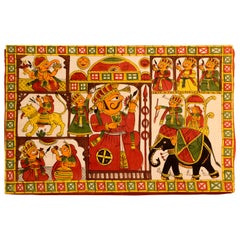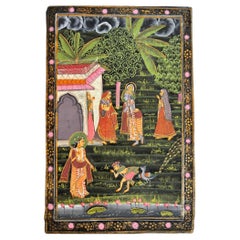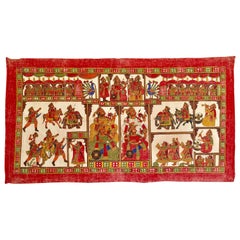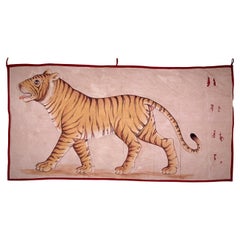Rajasthan Painted Screen
Vintage 1950s Indian Folk Art Paintings and Screens
Silk
Mid-20th Century Indian Anglo-Indian Paintings and Screens
Silk
Recent Sales
20th Century Indian Anglo Raj Paintings and Screens
Cotton
Antique Late 19th Century Indian Paintings and Screens
Cotton
People Also Browsed
Antique 19th Century Chinese Chinese Export Paintings
Silk, Wood
2010s American Organic Modern Vases
Ceramic, Cotton
2010s Italian Modern Wall Lights and Sconces
Brass
Antique Late 19th Century Korean Folk Art Paintings and Screens
Brocade, Silk, Wood
Antique Early 1900s Indian Sculptures and Carvings
Bronze
21st Century and Contemporary Vietnamese Modern End Tables
Wood
Early 20th Century French Art Nouveau Planters, Cachepots and Jardinières
Majolica
Antique Early 1900s Austrian Art Nouveau Vases
Earthenware, Glass
1990s Indian Anglo-Indian Desks and Writing Tables
Bone, Teak
Antique Early 1800s English Prints
Paper
Antique Early 1900s Czech Art Nouveau Vases
Art Glass
Antique Early 1800s French Prints
Glass, Giltwood, Paper
Antique 1890s Austrian Art Nouveau Vases
Porcelain
Mid-20th Century French French Provincial Wall Lights and Sconces
Brass
Mid-20th Century English Art Deco Beds and Bed Frames
Iron
Antique 19th Century Indian Sculptures and Carvings
Wood
Rajasthan Painted Screen For Sale on 1stDibs
How Much is a Rajasthan Painted Screen?
Finding the Right Paintings-screens for You
Traditional Asian paintings were often created on scrolls and folding screens. Artisans made screens that could be folded up or spread out by connecting several panels using hinges. Today, antique Asian folding screens and paintings are sophisticated decorative accents that can serve as makeshift partitions to ensure privacy.
The original folding screens were created by Chinese artists. The earliest record of screens comes from the 2nd century B.C., and surviving examples date back to the Ming dynasty. Chinese painting utilizes many of the same tools as calligraphy — these screens were crafted from wood with painted panels featuring striking art or calligraphy that told cultural stories or represented nature and life in the area.
The practice was introduced to Japan, where paintings for screens were made on paper and silk, in the 8th century. These paintings frequently feature subjects such as landscapes, animals, flowers and Buddhist religious themes. Along with screens for tea ceremonies and dance backgrounds, there were screens for use in Shinto and Buddhist temples.
In the 17th century, screens began to be imported to Europe where their popularity grew. Coco Chanel famously collected Coromandel folding screens.
Traditional Asian paintings can make a tasteful addition to any wall, and screens can be used as decoration or, in the case of larger iterations, as an aesthetic way to divide a large room. Browse the selection of antique Asian paintings and screens from a variety of styles and eras on 1stDibs.
- 1stDibs ExpertApril 5, 2022Japanese screen painting is the art of creating byōbu, or Japanese screens. Byōbu vary in subject matter and style. The screens are free-standing, portable and decorated with symbolic images or calligraphy. It is common to find byōbu in pairs with at least two panels. Shop a selection of byōbu on 1stDibs.
Read More
Symbols of Happiness and Rebirth Adorn This Japanese Satsuma Bowl
Decorated with white cranes and the sought-after thousand-butterflies motif, the Meiji-period vessel offers both a celebration of traditional aesthetics and a clear reflection of the era’s appetite for exquisite export pieces.
Chicago’s Pagoda Red Has a Spirited Mix of Asian Antiques and Bold New Art
For 25 years, gallerist Betsy Nathan has leveraged her keen eye and key connections to bring a unique selection of rare finds to the market.
In L.A., Gallerist JF Chen Has Long Championed Eclectic Blue-Chip Design
Now working alongside his daughter Bianca, dealer Joel Chen has presented a most covetable array of antiques, art and contemporary creations for more than 40 years.
12 Calming Spaces Inspired by Japanese Design
From cherry-blossom-adorned walls paired with glamorous lighting to wood-paneled ceilings above checkerboard-patterned chairs, these 12 spaces seamlessly blend Eastern and Western aesthetics.
Rodrigo Rivero Lake’s Mexico City Showroom Is a Museum-Worthy Trove of Spanish Colonial and Asian Antiques
The dealer and curator has spent the past 50 years amassing a collection of exceptional art, furniture and architectural elements that trace the cultural influence of the Spanish empire from Europe to the Americas and beyond.
16 Refined Asian-Inspired Interiors
These spaces exemplify how Eastern elements elevate a home's decor.



